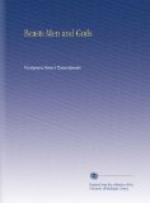Peking invited the Pandita Gheghen from Dolo Nor and the head of the Chinese Lamaites, the Hutuktu of Utai, both of whom do not recognize the supremacy of the Living Buddha, to come to the capital. They decided, after consulting the old Buddhistic books, that the present Bogdo Khan was to be the last Living Buddha, because that part of the Spirit of Buddha which dwells in the Bogdo Khans can abide only thirty-one times in the human body. Bogdo Khan is the thirty-first Incarnated Buddha from the time of Undur Gheghen and with him, therefore, the dynasty of the Urga Pontiffs must cease. However, on hearing this the Bogdo Khan himself did some research work and found in the old Tibetan manuscripts that one of the Tibetan Pontiffs was married and his son was a natural Incarnated Buddha. So the Bogdo Khan married and now has a son, a very capable and energetic young man, and thus the religious throne of Jenghiz Khan will not be left empty. The dynasty of the Chinese emperors disappeared from the stage of political events but the Living Buddha continues to be a center for the Pan-Asiatic idea.
The new Chinese Government in 1920 held the Living Buddha under arrest in his palace but at the beginning of 1921 Baron Ungern crossed the sacred Bogdo-Ol and approached the palace from the rear. Tibetan riders shot the Chinese sentries with bow and arrow and afterwards the Mongols penetrated into the palace and stole their “God,” who immediately stirred up all Mongolia and awakened the hopes of the Asiatic peoples and tribes.
In the great palace of the Bogdo a Lama showed me a special casket covered with a precious carpet, wherein they keep the bulls of the Dalai and Tashi Lamas, the decrees of the Russian and Chinese Emperors and the Treaties between Mongolia, Russia, China and Tibet. In this same casket is the copper plate bearing the mysterious sign of the “King of the World” and the chronicle of the last vision of the Living Buddha.
CHAPTER XLV
THE VISION OF THE LIVING BUDDHA OF MAY 17, 1921
“I prayed and saw that which is hidden from the eyes of the people. A vast plain was spread before me surrounded by distant mountains. An old Lama carried a basket filled with heavy stones. He hardly moved. From the north a rider appeared in white robes and mounted on a white horse. He approached the Lama and said to him:
“‘Give me your basket. I shall help you to carry them to the Kure.’
“The Lama handed his heavy burden up to him but the rider could not raise it to his saddle so that the old Lama had to place it back on his shoulder and continue on his way, bent under its heavy weight. Then from the north came another rider in black robes and on a black horse, who also approached the Lama and said:
“’Stupid! Why do you carry these stones when they are everywhere about the ground?’
“With these words he pushed the Lama over with the breast of his horse and scattered the stones about the ground. When the stones touched the earth, they became diamonds. All three rushed to raise them but not one of them could break them loose from the ground. Then the old Lama exclaimed:




